Five Pallet Freight Cargo Packing Guidelines.
You don’t have time to deal with the annoyances of damaged freight in a world where you’re expected to be competitive and streamlined at all times. Some shippers are unaware that they are their own greatest enemy when it comes to shipment. If you do not properly package your freight, you will not only have to deal with the damage but your freight claim will most likely be denied.
Fortunately, by properly preparing your freight from the start, you may reduce losses and the problems that come with freight claims. Pallets are one of the most effective techniques to reduce freight damage. However, you must understand the intricacies of shipping pallets in order to be adequately protected against freight damage.
Why are pallets used?
Why are pallets so popular among shippers? It boils down to three benefits.
Increase your profit margins.
Who wouldn’t like to make more money? You can maximize your freight class by packing containers with pallets. Your freight becomes more enticing to carriers by palletizing because it is easier to handle. Get Loaded and Rolling may help you raise your profit margins even further by consolidating your LTL pallets on one truck, allowing you to access complete truckload service and improving your bottom line.
Assist your carrier in assisting you.
Nobody is flawless, and your carrier may make an error that causes damage. However, by palletizing freight, you are ensuring the success of your carrier. For example, if you use forklift-friendly pallets and properly mark everything, you’re assisting your carrier in doing a better job. Everyone saves time and money as a result.
Reduce freight claims significantly.
Freight claims aren’t fun, but they’re necessary if your freight is damaged. Of course, if you package freight using pallets, you can avoid disputes from the start. This method reduces the fragility of your cargo and makes it easier to transport, which means you won’t be dealing with insurance claims left and right.
We don’t want to brag, but the majority of our Get Loaded and Rolling shippers never have to file a freight claim. Our patented algorithms enable shared truckload (STL) service, a simplified shipping method in which multiple shippers share trailer space in a single multi-stop truckload. (In addition, we are the only logistics supplier that offers STL shipping.)
STL service offers the customized experience of TL shipping at a quarter of the cost, and it avoids the requirement for LTL-size goods to pass through the damage-prone hub-and-spoke system. When shippers select Get Loaded and Rolling, our technology pools their freight with other loads traveling the same route and delivers each shipment in the shared truckload in one piece. Isn’t that much better than dealing with freight claims?

Five strategies for more efficient pallet freight shipment.
Your company must transfer things safely and quickly. Use these 5 tips to improve your shipping pallets and reduce freight claims.
1. Prepare the freight properly.
Your pallets are only as good as the boxes contained within them. Follow these essential practices to properly prepare your freight for palletizing.
- Stack with caution: Don’t get too inventive here. Stack your goods in columns to construct squares or rectangles. Because you don’t want anything leaning in transit, these shapes are ideal.
- Combine similar products: Bundling comparable things together can help to limit the damage. This will also make it easy to unload the cargo.
- Sheets of paper: To equally distribute the weight of the pallet, add a slip sheet between each layer of goods, whether plastic or cardboard.
- Stretch wrap and strapping should be used to secure everything to the pallet. Wrap it securely so that it moves as little as possible.
Because you’re shipping in lower numbers for LTL, it’s critical to properly prepare the freight to avoid damage.
2. Label with caution.
Don’t forget to label the pallet after you’ve finished preparing it for transportation. It may seem obvious, yet many shippers fail to offer suitable handling guidelines. Carriers cannot read your thoughts, and if they are not given clear instructions, they may mishandle your cargo, causing harm.
In order for carriers to know how to handle the pallet, include handling instructions, particular cautions about dangerous items, your contact information, and an inventory sheet.
3. Choose the appropriate pallet size.
Most pallets in the United States are 40″ by 48″. Some sizes are more popular than others, but it all depends on your industry, the commodity you’re shipping, and the size of the vehicle.
Choose a large enough pallet so that your cargo does not dangle over the side. Choose a pallet that enables four-way forklift or pallet jack access for quick, efficient sorting.
4. Weight should be distributed evenly.
Check the weight of your pallet. Pallets are typically no heavier than 1,650 pounds. The heaviest goods should be placed on the bottom and evenly distributed with each layer. Too much weight on the top or one side of the pallet risks tipping it over in shipment, resulting in a freight claim.
5. Select the appropriate freight class.
Palletizing not only reduces damage but also has the potential to save you money. If you handle pallet shipping correctly, you may be able to qualify for a lower freight class, saving you a significant amount of money.
If freight class sounds like a hassle, inquire with your carrier about pallet pricing. This rate is based on conventional pallet size and weight rather than freight class. It’s an excellent technique to increase the predictability of your freight prices.
Palletize rather than agonize.
Pallets reduce damage, help you avoid the hassles of freight claims, and increase the efficiency of your operation. Ship freight safely using pallets and avoid unwanted claims to increase your profits.
If you’re interested in learning more about shipping with Get Loaded and Rolling, now is the best time to get started. Sign up with Get Loaded and Rolling today.
